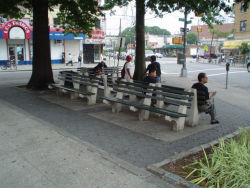American Triangle
American Triangle
American Triangle is a small patch of green nestled between 41st Avenue, 102nd Street, and National Avenue, in the Queens neighborhood of Corona. Originally named National Triangle after the adjacent road, Parks Commissioner Stern renamed the site American Triangle in 1997.
The Corona area began as West Flushing in 1854, when a group of speculators from the City of New York developed the area and named it after its 200-year-old neighbor to the east. That year also saw the beginning of regional Long Island Rail Road service and the opening of the National Race Course. Developers planned the streets around the railroad route, rapidly increasing settlement in the following years. In 1856, the National Race Course was renamed Fashion Race Track, after a champion horse. The racetrack became a major attraction, featuring the new sport of harness-racing. With the construction of lavish new tracks in Fordham and Sheepshead Bay, however, and with a resurgence of thoroughbred racing, the track closed down forever in 1866.
In 1867, music publisher and land developer Benjamin W. Hitchcock extended his influence into West Flushing by buying up 1200 parcels of land. He also saw to the opening of a Flushing Rail Road station at National Avenue. The town grew in population and prominence and by 1872, its residents wanted a name change that would distinguish it from Flushing, and express pride in their flourishing community. West Flushing became “Corona,” a Latin term for “crown,” designating it as the “crown” of all towns on Long Island. During the latter half of the 19th century, Corona became home to many factories producing goods as varied as portable houses, fine china, and Tiffany glass.
Corona continued to thrive, and the defunct racetrack site provided space for new housing and commercial development right in the heart of the neighborhood. Its population had reached 2,500 by 1898 and 6,200 by 1910. The introduction of rapid transit in 1917 spurred further and greater population growth for Corona than in any previous period. Home to a predominantly Italian and Jewish population, Corona has experienced a huge influx of Latin American immigrants since the end of World War II. Among its most famous residents, the great jazz musician Louis Armstrong (1901-1971) lived here from 1943 until his death.
In August 1993 renovations on the American Triangle included sidewalk reconstruction, tree plantings, and the installation of new benches, tree pits, granite block, hexagonal tile pavement, and cast iron bollards. There are large trees at two of the triangle’s corners and on the site’s third corner is planted a small cluster of flora and a young tree.
Check out your park's Vital Signs
Clean & Safe
Green & Resilient
Empowered & Engaged Users
Share your feedback or learn more about how this park is part of a
Vital Park System




